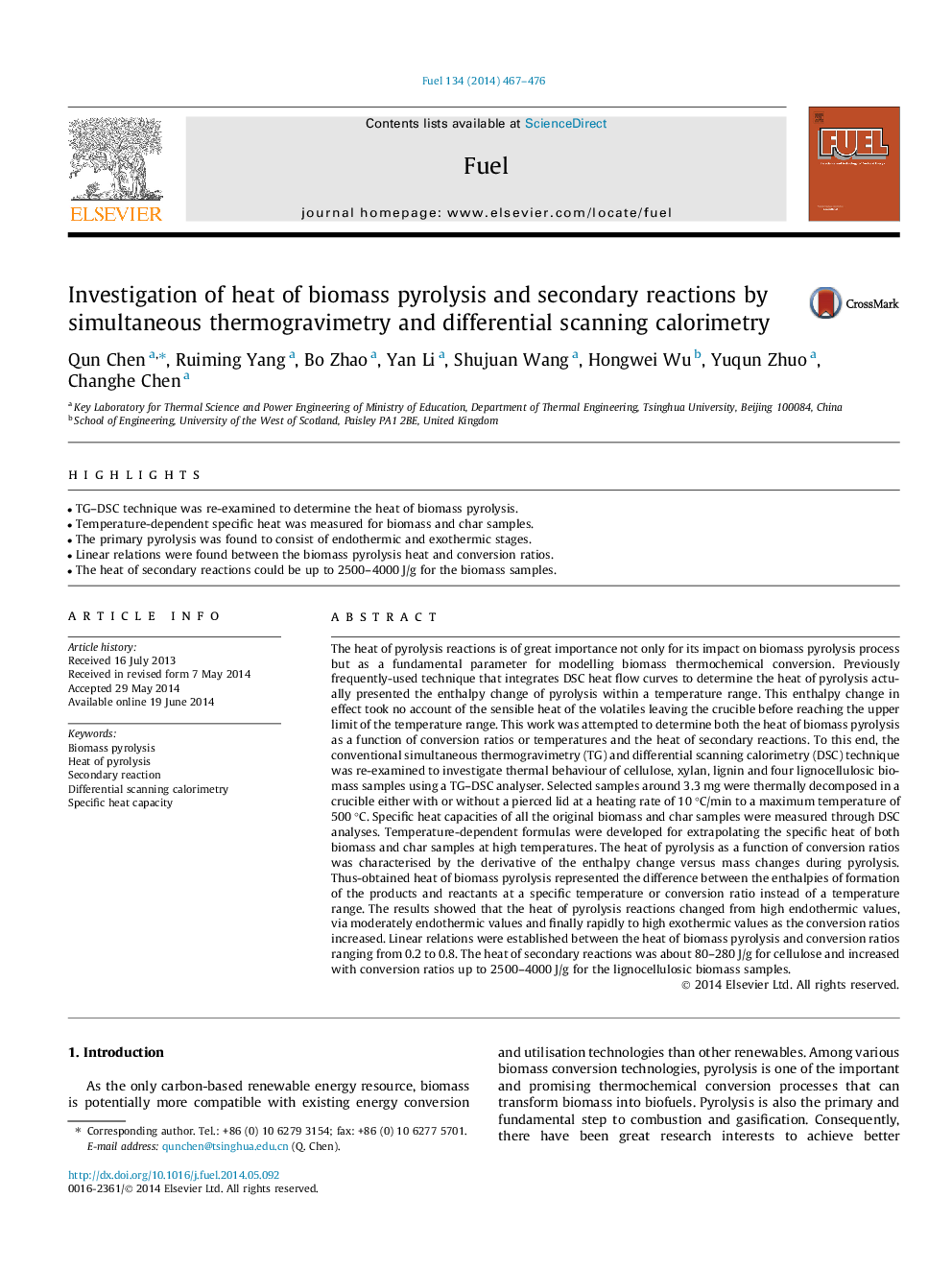| کد مقاله | کد نشریه | سال انتشار | مقاله انگلیسی | نسخه تمام متن |
|---|---|---|---|---|
| 6637296 | 461139 | 2014 | 10 صفحه PDF | دانلود رایگان |
عنوان انگلیسی مقاله ISI
Investigation of heat of biomass pyrolysis and secondary reactions by simultaneous thermogravimetry and differential scanning calorimetry
ترجمه فارسی عنوان
بررسی گرمای زیست توده ی پیلوریس و واکنش های ثانویه با استفاده از روش گرماگروگرمتری همزمان و کالوریمتری اسکن دیفرانسیل
دانلود مقاله + سفارش ترجمه
دانلود مقاله ISI انگلیسی
رایگان برای ایرانیان
کلمات کلیدی
پیرولیز زیست توده، گرما از پیلوریس، واکنش ثانویه، کالریمتری اسکن دیفرانسیل، ظرفیت گرمای ویژه،
موضوعات مرتبط
مهندسی و علوم پایه
مهندسی شیمی
مهندسی شیمی (عمومی)
چکیده انگلیسی
The heat of pyrolysis reactions is of great importance not only for its impact on biomass pyrolysis process but as a fundamental parameter for modelling biomass thermochemical conversion. Previously frequently-used technique that integrates DSC heat flow curves to determine the heat of pyrolysis actually presented the enthalpy change of pyrolysis within a temperature range. This enthalpy change in effect took no account of the sensible heat of the volatiles leaving the crucible before reaching the upper limit of the temperature range. This work was attempted to determine both the heat of biomass pyrolysis as a function of conversion ratios or temperatures and the heat of secondary reactions. To this end, the conventional simultaneous thermogravimetry (TG) and differential scanning calorimetry (DSC) technique was re-examined to investigate thermal behaviour of cellulose, xylan, lignin and four lignocellulosic biomass samples using a TG-DSC analyser. Selected samples around 3.3 mg were thermally decomposed in a crucible either with or without a pierced lid at a heating rate of 10 °C/min to a maximum temperature of 500 °C. Specific heat capacities of all the original biomass and char samples were measured through DSC analyses. Temperature-dependent formulas were developed for extrapolating the specific heat of both biomass and char samples at high temperatures. The heat of pyrolysis as a function of conversion ratios was characterised by the derivative of the enthalpy change versus mass changes during pyrolysis. Thus-obtained heat of biomass pyrolysis represented the difference between the enthalpies of formation of the products and reactants at a specific temperature or conversion ratio instead of a temperature range. The results showed that the heat of pyrolysis reactions changed from high endothermic values, via moderately endothermic values and finally rapidly to high exothermic values as the conversion ratios increased. Linear relations were established between the heat of biomass pyrolysis and conversion ratios ranging from 0.2 to 0.8. The heat of secondary reactions was about 80-280 J/g for cellulose and increased with conversion ratios up to 2500-4000 J/g for the lignocellulosic biomass samples.
ناشر
Database: Elsevier - ScienceDirect (ساینس دایرکت)
Journal: Fuel - Volume 134, 15 October 2014, Pages 467-476
Journal: Fuel - Volume 134, 15 October 2014, Pages 467-476
نویسندگان
Qun Chen, Ruiming Yang, Bo Zhao, Yan Li, Shujuan Wang, Hongwei Wu, Yuqun Zhuo, Changhe Chen,
